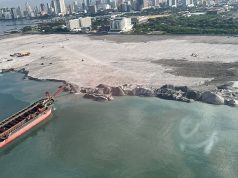
Concerns over possible environmental impacts of fireworks arose when a chain of shopping malls announced that it changed the venue of its pyromusical competition due to the ongoing Manila Bay rehabilitation.
SM Supermalls revealed that the 10th Philippine International Pyromusical Competition would be happening in SM City Clark at Angeles, Pampanga from February 9 to March 30, 2019.
Its usual venue is by the Seaside Boulevard at the SM Mall of Asia in Pasay City, right beside Manila Bay.
SM claimed that its pyrotechnics “have always complied with the international standards for environment safety, at par with countries like Canada, Australia, Hong Kong and other famous theme parks around the world.”
Fireworks negatively affect the environment due to the amount of pollution that it produces in the form of smoke and solid waste.
Last January, the Department of Environment and Natural Resources requested the management of SM Mall of Asia to stop the pyromusical competition in consideration of the Manila Bay rehabilitation.
Environmental Undersecretary Benny Antiporda claimed that materials used in the fireworks display would fall into the natural harbor such as powder, paper and heavy metal.

“We cannot afford na madagdagan pa ‘yong pollution ng Manila Bay, though alam naman natin na ‘pag pumutok ‘yan, bumagsak ang mga papel, may heavy metals ‘yan na kasama sa pulbura,” he said in an interview.
Fireworks and the environment
Pyrotechnic products contain various chemicals that include propellants, oxidizers, color-producing compounds that could harm the environment in high amounts.
An article discussed the different types of pollutants within a pyrotechnic product, including gases that are deemed dangerous.
“When fireworks burn or explode, they shoot out noxious gases, such as oxides of nitrogen and sulphur, and tiny particles of solids, all in levels greater than those produced by traffic exhausts. From the largest cake fireworks down to the tiniest indoor sparklers, they all cause similar air pollution,” it reported.
Zinc is used to produce smoke effects while different metallic compounds are used to make the fireworks colorful.
Strontium or lithium produces the color of red, calcium produces orange, sodium produces yellow, barium produces green, copper produces blue, caesium produces indigo, potassium or rubidium produces violet and aluminum, beryllium, magnesium or titanium produce the color of white.
Researchers from the King’s College London and the University of Birmingham noted that these kinds of chemicals “can lead to concentrations of particulate matter that exceed air pollution safety limits.”
In January 2018, DENR reported that the level of air pollution in Metro Manila have decreased following the government’s stricter regulations on fireworks.









